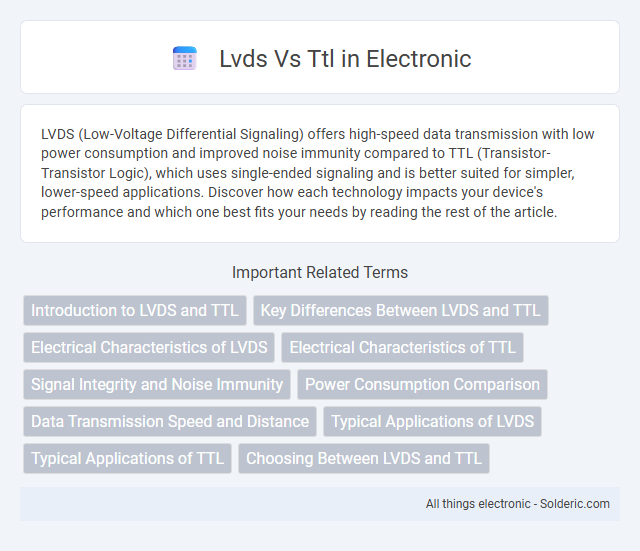LVDS (Low-Voltage Differential Signaling) offers high-speed data transmission with low power consumption and improved noise immunity compared to TTL (Transistor-Transistor Logic), which uses single-ended signaling and is better suited for simpler, lower-speed applications. Discover how each technology impacts your device's performance and which one best fits your needs by reading the rest of the article.
Comparison Table
| Feature | LVDS (Low-Voltage Differential Signaling) | TTL (Transistor-Transistor Logic) |
|---|---|---|
| Signal Type | Differential | Single-ended |
| Voltage Levels | Typically 350 mV differential | 0 to 5 V or 0 to 3.3 V |
| Speed | High speed, up to several Gbps | Lower speed, typically up to 30 Mbps |
| Power Consumption | Low power consumption | Higher power consumption |
| Noise Immunity | Excellent, due to differential signaling | Lower, susceptible to noise |
| Cabling | Twisted pair or shielded cables preferred | Unshielded cables sufficient |
| Applications | High-speed data transfer, LCD interfaces, communication links | Simple digital circuits, microcontroller inputs |
Introduction to LVDS and TTL
LVDS (Low-Voltage Differential Signaling) transmits data using differential pairs at low voltage levels, reducing noise and electromagnetic interference, ideal for high-speed communication in modern electronics. TTL (Transistor-Transistor Logic) operates on single-ended digital signals with higher voltage swings, commonly used in traditional digital circuits for logic-level signaling. LVDS offers superior signal integrity and lower power consumption compared to TTL, making it suitable for high-frequency applications such as display interfaces and data acquisition systems.
Key Differences Between LVDS and TTL
LVDS (Low Voltage Differential Signaling) utilizes differential signaling with two wires per signal, offering high noise immunity and low power consumption, while TTL (Transistor-Transistor Logic) relies on single-ended signaling with higher voltage levels and greater power usage. LVDS supports higher data rates typically up to several Gbps, making it suitable for high-speed data transmission in applications like LCD displays and high-frequency communications, whereas TTL is commonly used for lower-speed digital logic in microcontrollers and simple digital circuits. The impedance and signal integrity advantages of LVDS result in longer cable lengths and reduced electromagnetic interference compared to TTL's shorter transmission distances and increased susceptibility to noise.
Electrical Characteristics of LVDS
LVDS (Low Voltage Differential Signaling) operates with a differential voltage of approximately 350 mV across a 100 O load, resulting in low power consumption and minimal electromagnetic interference. It uses a constant current source of about 3.5 mA, which enhances signal integrity and allows for high-speed data transmission up to several Gbps. The LVDS electrical characteristics contribute to its superior noise immunity and longer cable lengths compared to TTL (Transistor-Transistor Logic) signals.
Electrical Characteristics of TTL
TTL (Transistor-Transistor Logic) operates with a typical voltage range of 0 to 5 volts, where a logic low is between 0 to 0.8 volts and a logic high ranges from 2 to 5 volts, making it compatible with many microcontrollers and digital circuits. It features relatively higher power consumption and slower switching speeds compared to Low-Voltage Differential Signaling (LVDS). Your design should consider TTL's single-ended signaling and susceptibility to noise, which may affect performance in high-speed or long-distance data transmission scenarios.
Signal Integrity and Noise Immunity
LVDS offers superior signal integrity compared to TTL by operating at low voltage differential signaling, which minimizes electromagnetic interference and crosstalk. TTL signals, relying on single-ended voltage levels, are more susceptible to noise and signal degradation over longer distances. If your application requires robust noise immunity and reliable data transmission in electrically noisy environments, LVDS is the preferred choice.
Power Consumption Comparison
LVDS (Low Voltage Differential Signaling) consumes significantly less power than TTL (Transistor-Transistor Logic) due to its low voltage swing and differential signaling method, typically operating around 350 mV compared to TTL's 5 V. LVDS can achieve data transmission rates of several Gbps at power levels as low as a few milliwatts per channel, making it ideal for high-speed, low-power applications. TTL circuits generally require higher current and voltage, resulting in greater power consumption, which limits their use in energy-sensitive and high-frequency environments.
Data Transmission Speed and Distance
LVDS (Low Voltage Differential Signaling) supports higher data transmission speeds up to several Gbps and can maintain signal integrity over long distances exceeding 10 meters due to its differential signaling and low noise susceptibility. TTL (Transistor-Transistor Logic), operating at single-ended signaling, is generally limited to lower speeds around tens of Mbps and shorter cable lengths typically under 1 meter due to increased noise and signal degradation. For high-speed, long-distance data transmission applications, LVDS offers superior performance compared to TTL.
Typical Applications of LVDS
LVDS (Low-Voltage Differential Signaling) is widely used in high-speed data transmission applications such as LCD display interfaces, telecommunications, and high-performance computing systems. It offers low power consumption and noise immunity, making it ideal for long cable runs and environments with high electromagnetic interference. Your choice of LVDS ensures reliable, high-frequency data transfer in devices like digital cameras, automotive avionics, and industrial automation.
Typical Applications of TTL
TTL (Transistor-Transistor Logic) is commonly used in low-speed digital circuits, microcontrollers, and simple communication interfaces due to its ease of integration and lower power consumption. Typical applications of TTL include serial communication protocols, LED displays, and basic logic gate circuits in embedded systems. Its voltage levels and compatibility with standard logic ICs make TTL suitable for short-distance signal transmission in consumer electronics and automotive systems.
Choosing Between LVDS and TTL
Choosing between LVDS (Low Voltage Differential Signaling) and TTL (Transistor-Transistor Logic) depends on your application's data transmission requirements and noise immunity. LVDS offers high-speed communication with low power consumption and excellent noise resistance, ideal for long-distance or high-frequency data transfer. TTL provides simpler design and compatibility with older systems but lacks the noise immunity and speed advantages of LVDS, making it better suited for short-distance, low-speed connections.
lvds vs ttl Infographic

 solderic.com
solderic.com